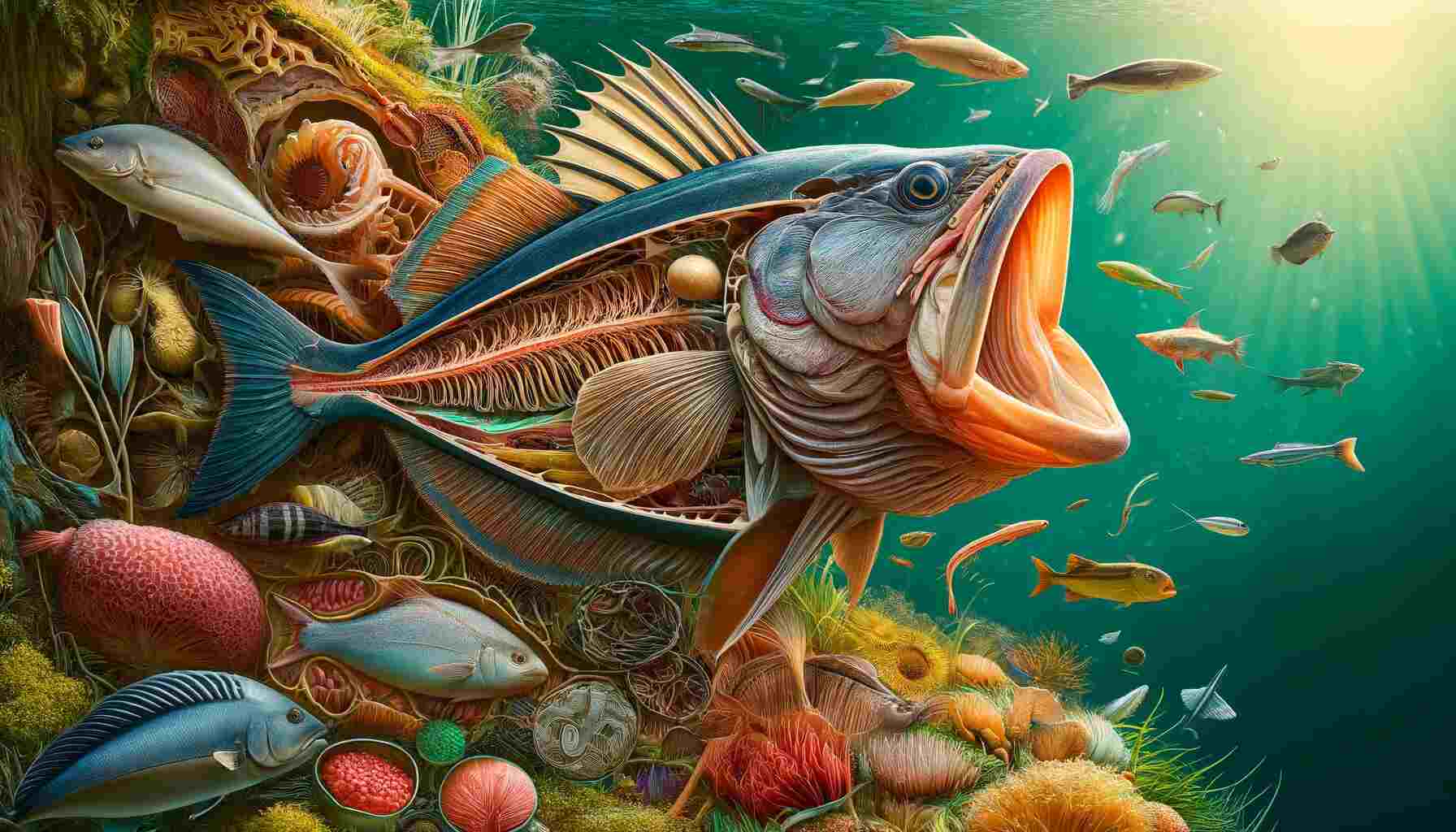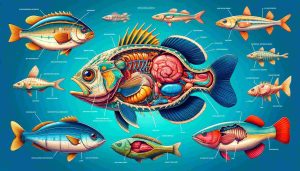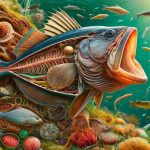Fish respiration is a fascinating and complex process that enables these aquatic creatures to extract oxygen from water, a medium that contains significantly less oxygen than air. This article delves into the science behind how fish breathe underwater, exploring the role of gills, the physiological mechanisms involved, and the variations across different species.
Table of Contents
Introduction to Fish Respiration
Fish live in an environment that presents unique challenges for respiration. Water, unlike air, contains only a fraction of the oxygen available in the atmosphere—about 1% compared to 21% in air. Despite this, fish have evolved highly efficient systems to extract the necessary oxygen to sustain their metabolic processes. Central to this system are the gills, specialized organs that facilitate the exchange of gases between the fish and its watery environment.
The Role of Gills in Fish Respiration
Structure and Function of Gills
Gills are the primary respiratory organs in fish. They are typically located on either side of the fish’s head and are composed of gill arches, which support gill filaments. These filaments are covered in tiny, thin-walled structures called lamellae, which are rich in capillaries. The structure of gills maximizes the surface area available for gas exchange, which is crucial given the low oxygen content of water.
Gill Arches and Filaments
The gill arches are bony or cartilaginous structures that provide support to the gill filaments. Each gill arch can support hundreds of gill filaments, which are thin, elongated structures that extend into the water. The filaments are arranged in pairs on either side of the gill arch, creating a large surface area for water to flow over.
Lamellae
Lamellae are the site of gas exchange within the gills. These are thin, plate-like structures that cover the gill filaments. Blood flows through the capillaries in the lamellae, allowing for the diffusion of oxygen from the water into the blood and the release of carbon dioxide from the blood into the water. The thin walls of the lamellae and their extensive network of capillaries make this process efficient.
Counter-Current Exchange System
One of the key adaptations that enhance the efficiency of gas exchange in fish is the counter-current exchange system. In this system, blood flows through the lamellae in the opposite direction to the flow of water over the gills. This arrangement ensures that the concentration gradient for oxygen remains steep throughout the length of the gill filament, allowing for maximum oxygen uptake.
Efficiency of Counter-Current Exchange
The counter-current exchange mechanism ensures that even when water leaves the gills, it still has a higher concentration of oxygen compared to the blood exiting the gills. This gradient allows for continuous diffusion of oxygen into the blood and carbon dioxide out of the blood, making the process highly efficient.
Differences in Fish Respiration Across Species
Fish species vary widely in their respiratory adaptations, reflecting their diverse habitats and lifestyles. From fast-swimming pelagic fish to sedentary bottom-dwellers, each species has evolved specific features to optimize oxygen uptake in their particular environment.
Pelagic Fish
Pelagic fish, such as tuna and mackerel, are adapted to life in the open ocean where they must swim continuously to find food and avoid predators. These fish often have highly efficient gills with a large surface area to meet their high metabolic demands. They also possess adaptations like ram ventilation, where they swim with their mouths open to force water over their gills, thereby increasing oxygen uptake.
Case Study: Tuna
A study conducted by Brill and Bushnell (2001) found that yellowfin tuna can extract up to 50% of the available oxygen from water, compared to only 25% in most other fish species. This high efficiency is due to their large gill surface area and the rapid flow of water over their gills facilitated by their constant swimming.
Demersal Fish
Demersal fish, such as flounder and cod, live near the ocean floor and often have lower metabolic rates compared to pelagic species. Their gills may have fewer filaments and lamellae, reflecting their lower oxygen requirements. Some demersal fish also have specialized structures to help them extract oxygen from sediment-laden water.
Freshwater Fish
The freshwater fish, such as carp and catfish, face different challenges compared to their marine counterparts. Freshwater environments can vary greatly in terms of oxygen availability, temperature, and water flow. Many freshwater fish have adaptations that allow them to survive in low-oxygen conditions, such as the ability to gulp air from the surface or specialized labyrinth organs that extract oxygen from air.
Unique Finding: Air-Gulping Behavior
Research by Chapman and Hulen (2001) on the African lungfish (Protopterus annectens) revealed that these fish can survive in water with oxygen levels as low as 0.5 mg/L by gulping air from the surface. This adaptation allows them to inhabit oxygen-poor waters that would be uninhabitable for other fish species.
Unique Adaptations in Fish Respiration
Air-Breathing Fish
Some fish species have evolved the ability to breathe air to survive in environments where water oxygen levels are particularly low. Fish such as lungfish and some catfish have developed structures like lungs or modified swim bladders that allow them to extract oxygen from the air. These adaptations enable them to survive in hypoxic (low-oxygen) waters or even out of water for extended periods.
Cutaneous Respiration
In addition to gills, some fish can absorb oxygen directly through their skin, a process known as cutaneous respiration. This is especially important for small fish or larvae that have a high surface area to volume ratio. Cutaneous respiration can supplement gill respiration and is particularly useful in low-oxygen environments.
The Physiological Mechanisms of Fish Respiration
Understanding the physiological mechanisms behind fish respiration requires a look at the process of gas exchange at the cellular level, the role of hemoglobin in oxygen transport, and the regulation of respiratory processes.
Gas Exchange at the Cellular Level
Gas exchange in fish occurs primarily in the lamellae, where oxygen diffuses from the water into the blood while carbon dioxide diffuses from the blood into the water. This process is driven by the differences in partial pressures of these gases between the water and the blood. The thin walls of the lamellae and the close proximity of blood capillaries to the water facilitate efficient diffusion.
Role of Hemoglobin
Hemoglobin, the oxygen-carrying protein in fish blood, plays a crucial role in transporting oxygen from the gills to the tissues. Fish hemoglobin has a high affinity for oxygen, allowing it to bind oxygen efficiently even at the low concentrations found in water. Once oxygen is bound to hemoglobin, it is transported through the bloodstream to the tissues, where it is released to support cellular respiration.
Oxygen Dissociation Curve
The oxygen dissociation curve for fish hemoglobin is typically sigmoidal, indicating cooperative binding. This means that the binding of one oxygen molecule to hemoglobin increases its affinity for additional oxygen molecules. This property enhances the efficiency of oxygen uptake at the gills and release at the tissues.
Regulation of Respiration
Fish regulate their respiration through a combination of behavioral and physiological mechanisms. For example, fish can adjust their swimming speed and mouth opening to control the flow of water over their gills. Additionally, chemoreceptors in the fish’s body can detect changes in oxygen and carbon dioxide levels, triggering adjustments in gill ventilation and blood flow to maintain optimal gas exchange.
Environmental Factors Affecting Fish Respiration
Various environmental factors can influence the efficiency of fish respiration, including water temperature, salinity, oxygen levels, and the presence of pollutants.
Temperature
Water temperature has a significant impact on fish respiration. As temperature increases, the metabolic rate of fish also increases, leading to higher oxygen demands. However, warm water holds less oxygen than cold water, creating a challenging situation for fish. Fish must adjust their behavior and physiology to cope with these changes, such as increasing their gill ventilation rate or seeking cooler, oxygen-rich waters.
Statistical Insight
A study by Fry (1971) indicated that for every 10°C increase in water temperature, the metabolic rate of fish approximately doubles, increasing their oxygen consumption. This phenomenon, known as Q10, underscores the significant impact of temperature on fish respiration.
Salinity
Salinity affects the solubility of gases in water and the osmoregulatory processes in fish. Marine fish, which live in high-salinity environments, have specialized adaptations to maintain osmotic balance while extracting oxygen. Conversely, freshwater fish have adaptations to cope with low salinity and varying oxygen levels.
Research Findings
Research by Evans et al. (2005) showed that marine fish can adjust their gill permeability to ions to maintain osmotic balance in different salinity conditions, ensuring efficient oxygen uptake even in varying salinity levels.
Oxygen Levels
Oxygen levels in water can fluctuate due to factors such as temperature, water flow, and biological activity. Fish living in environments with low oxygen levels, such as swamps or stagnant ponds, have developed various adaptations to survive. These include increased gill surface area, higher hemoglobin affinity for oxygen, and the ability to breathe air.
Case Study: Amazonian Fish
A study by Brauner and Val (1996) on Amazonian fish species revealed that many of these fish have evolved air-breathing capabilities to survive in the oxygen-depleted waters of the Amazon Basin. This adaptation allows them to thrive in an environment with extreme fluctuations in oxygen availability.
Pollutants
The pollutants such as chemicals, heavy metals, and organic waste can impair gill function and reduce the efficiency of oxygen uptake in fish. Pollutants can damage the delicate structures of the gills, interfere with the function of respiratory proteins, and create hypoxic conditions. Fish exposed to polluted environments must expend more energy on respiration and may experience reduced growth and reproductive success.
Environmental Impact Studies
A comprehensive review by Wu et al. (2003) highlighted that exposure to pollutants like ammonia and heavy metals significantly impairs the gill function of fish, leading to reduced oxygen uptake and increased mortality rates.
Evolutionary Adaptations in Fish Respiration
The diversity of fish species and their habitats has driven the evolution of various respiratory adaptations. These adaptations have enabled fish to exploit a wide range of ecological niches, from the deepest ocean trenches to high-altitude freshwater lakes.
Evolution of Gills
The evolution of gills in fish represents a key innovation that allowed early aquatic vertebrates to efficiently extract oxygen from water. Over millions of years, gill structures have become more complex and efficient, reflecting the diverse respiratory demands of different species. The development of lamellae, counter-current exchange systems, and specialized respiratory proteins are all evolutionary adaptations that have enhanced the efficiency of fish respiration.
Fossil Evidence
Fossil records indicate that early fish-like vertebrates, such as ostracoderms from the Silurian period, possessed primitive gill structures that laid the groundwork for the sophisticated gills seen in modern fish. This evolutionary progression highlights the importance of gills in the survival and diversification of aquatic vertebrates.
Transition to Air Breathing
The transition from water breathing to air breathing in some fish species represents another significant evolutionary adaptation. Air-breathing fish, such as lungfish and some catfish, have developed structures like lungs or modified swim bladders that allow them to survive in oxygen-poor water or even on land. These adaptations have enabled these species to exploit new habitats and resources, contributing to their evolutionary success.
Study on Lungfish
Research by Graham and Lee (2004) on lungfish respiration demonstrated that these fish can switch between gill and lung respiration depending on the availability of oxygen in their environment. This dual respiratory capability has allowed lungfish to survive in fluctuating conditions for millions of years.
Adaptations to Extreme Environments
Some fish species have evolved respiratory adaptations to survive in extreme environments, such as deep-sea habitats or high-altitude lakes. Deep-sea fish, for example, may have specialized hemoglobin with a high affinity for oxygen, allowing them to extract oxygen efficiently at great depths where oxygen levels are low. High-altitude fish have adaptations to cope with low oxygen levels and variable temperatures, such as increased gill surface area and efficient oxygen transport mechanisms.
Deep-Sea Adaptations
A study by Childress and Seibel (1998) found that deep-sea fish possess hemoglobin with a significantly higher affinity for oxygen compared to shallow-water species. This adaptation is crucial for surviving in the oxygen-poor environments of the deep ocean.
Conclusion
The science of fish respiration reveals a remarkable array of adaptations that enable these aquatic creatures to thrive in diverse and often challenging environments. From the intricate structure of gills to the sophisticated counter-current exchange system, fish have evolved highly efficient mechanisms to extract oxygen from water. The variations in respiratory adaptations across different species underscore the evolutionary ingenuity that has allowed fish to occupy virtually every aquatic habitat on Earth. Understanding these processes not only deepens our appreciation of fish biology but also highlights the importance of preserving the aquatic environments that support these remarkable organisms.
Helpful Statistics, Studies, and Links
- Yellowfin Tuna Efficiency: Brill, R. W., & Bushnell, P. G. (2001). The cardiovascular system of tunas. In: Tuna: Physiology, Ecology, and Evolution (pp. 79-120). Academic Press.
- Air-Gulping in Lungfish: Chapman, L. J., & Hulen, K. G. (2001). Implications of hypoxia for the brain size and gill morphometrics of a lake Victoria cichlid fish. Journal of Zoology, 253(2), 175-188.
- Metabolic Rate and Temperature (Q10 Effect): Fry, F. E. J. (1971). The effect of environmental factors on the physiology of fish. Fish Physiology, 6, 1-98.
- Osmoregulation in Marine Fish: Evans, D. H., Piermarini, P. M., & Choe, K. P. (2005). The multifunctional fish gill: Dominant site of gas exchange, osmoregulation, acid-base regulation, and excretion of nitrogenous waste. Physiological Reviews, 85(1), 97-177.
- Amazonian Fish Air-Breathing Adaptations: Brauner, C. J., & Val, A. L. (1996). Oxygen transfer. In: The Physiology of Fishes, Second Edition (pp. 277-306). CRC Press.
- Pollutant Impact on Gill Function: Wu, R. S. S., Lam, P. K. S., & Richardson, B. J. (2003). Causes and consequences of hypoxia in marine environments. Environmental Pollution, 122(3), 399-413.
- Evolution of Gills in Fossil Fish: Janvier, P. (1996). Early Vertebrates. Oxford University Press.
- Lungfish Dual Respiration: Graham, J. B., & Lee, H. J. (2004). Breathing air in water and in air: The air-breathing fishes. In: Fish Respiration (pp. 1-44). Academic Press.
- Deep-Sea Fish Hemoglobin Adaptations: Childress, J. J., & Seibel, B. A. (1998). Life at stable low oxygen levels: Adaptations of animals to oceanic oxygen minimum layers. Journal of Experimental Biology, 201(8), 1223-1232.
These studies and findings offer a deeper understanding of the complex and varied mechanisms of fish respiration, providing valuable insights into the adaptability and resilience of these fascinating aquatic organisms.




